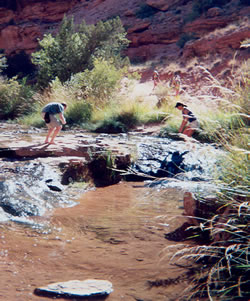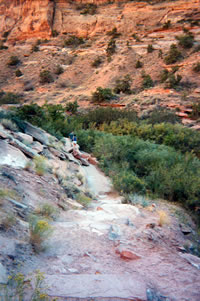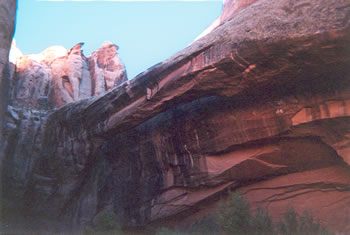 I
knew I would love this hike. Still, Negro Bill Canyon and the
Morning Glory Bridge far surpassed my expectations in every
way. I
knew I would love this hike. Still, Negro Bill Canyon and the
Morning Glory Bridge far surpassed my expectations in every
way.
The Bureau of Land Management trail (which have become my personal favorites
for their convenience, relative ruggedness and dog-and-kid friendliness)
is just over two miles from Highway 191 in Moab on State Highway 128,
also known as the River Road. A large pullout on the right side of the
road is usually full of cars, testimony to the trail’s popularity,
yet I encountered few people one late afternoon in mid-September as I
traversed the creek bed, prickly pear forests and boulders to the end
of the trail.
Negro Bill Canyon is named for one of Moab’s first non-native settlers,
William Granstaff, who came to the valley in 1877. It’s easy to
imagine why William chose this canyon; a perennial, clear-running stream
meanders and is home to beaver, who build and rebuild pools inviting
to the meekest swimmers or waders. The pools are surrounded by sand;
perfect for picnicking, and juniper berries, the fruit of prickly pear
and a variety of sweet-smelling, delicate and vividly colorful flowers
grace the path to this day. Fish spawn and swim at your feet as you cross
the creek several times on the way to Morning Glory Bridge, a “natural
bridge” boasting recognition as the sixth largest rock span – 243
feet - in the United States.
 The
elevation gain on this hike is 330 feet, most of it gradual with
sharper inclines just before what locals call “the first
side canyon,” and again just before the end of the trail.
It used to be hikers could get lost or confused on their way
to Morning Glory Arch, and it could still happen. But suspect
junctures are marked with trail signs, and cairns are more prevalent
as the landscape widens and dirt and sand paths turn to rock
from rim to rim. Most of the trail is narrow, which makes it
a good hike with young children and pets because they can’t
run off. It is also shaded much of the way, and with the pools
I found myself wondering ‘Why be hot in Moab?’ This
place is cool. The
elevation gain on this hike is 330 feet, most of it gradual with
sharper inclines just before what locals call “the first
side canyon,” and again just before the end of the trail.
It used to be hikers could get lost or confused on their way
to Morning Glory Arch, and it could still happen. But suspect
junctures are marked with trail signs, and cairns are more prevalent
as the landscape widens and dirt and sand paths turn to rock
from rim to rim. Most of the trail is narrow, which makes it
a good hike with young children and pets because they can’t
run off. It is also shaded much of the way, and with the pools
I found myself wondering ‘Why be hot in Moab?’ This
place is cool.
In fact, in the winter months
is when Negro Bill Canyon first attracted my attention because
of the beautiful, ornate icicles visible from the road. I
always thought it would be a good winter hike, but was warned
off because it does get slippery with ice on the trail a
couple of months out of the year. But until December, the
trail offers a colorful view of fauna native to this area
in abundance unlike Moab’s common landscape. It is
a Wilderness Study Area, and therefore protected from trampling
as it is being considered for eventual and total Wilderness
status.
Hikers may want to beware the also colorful poison ivy along this trail.
Because the trail is maintained, the ivy is relatively easy to avoid.
I took one wrong turn and in trying to avoid the ivy found myself full
of prickly pear – one thorn and hundreds of the cactus’s
small weapons, which I likened to a spear and hundreds of knives. I packed
them with mud and soaked in the stream and got them all out within 12
hours unscathed; prior to the literal “falling out,” I was
bragging to myself that the trail offered just enough “scramble” for
me to feel like a kid and not get hurt. I stand by that. It is a scramble
in places, and a fun one. Walking the trail felt like dancing in some
ways, and the stream offered the music.
 At
the Arch and Bridge, the sound intensifies. Powerful, rushing
water sounds with only a still, shallow marshy pool in sight.
I venture closer to the Bridge and see a trickle coming from
a rock formation a hundred feet above me. I sit at the foot of
this formation – the sixth largest in the U.S. and wonder,
is it another arch in the making? At
the Arch and Bridge, the sound intensifies. Powerful, rushing
water sounds with only a still, shallow marshy pool in sight.
I venture closer to the Bridge and see a trickle coming from
a rock formation a hundred feet above me. I sit at the foot of
this formation – the sixth largest in the U.S. and wonder,
is it another arch in the making?
It feels like it could happen any second, hence my apprehension, yet
it will probably take millennium. It makes me dizzy, and I run, like
a kid, back to the trailhead, hoping I catch my friends in time for dinner
in town. I did.
The trail is two miles one way, an easy two-to-three-hour hike. Bring
lots of water, your kid and/or dog, and food. Stay a while. The music
is good.
Bikes and vehicles are prohibited on the trail.
Cryptos (krip’ tose):
The surface of Moab’s desert is held together
by a thin skin of living organisms known as cryptobiotic
soil or cryptos. It has a lumpy black appearance,
is very fragile, and takes decades to heal when
it has been damaged. This soil is a critical part
of the survival of the desert. The cryptobiotic
organisms help to stabilize the soil, hold moisture,
and provide protection for germination of the seeds
of other plants.
Without
it the dry areas of the west would be much different.
Although some disturbance is normal and helps
the soil to capture moisture, excessive disturbance
by hooves, bicycle tires and hiking boots has
been shown to destroy the cryptobiotic organisms
and their contribution to the soil. When you
walk around Moab avoid crushing the cryptos.
Stay on trails, walk in washes, hop from stone
to stone.
Whatever
it takes, don’t crunch the cryptos unless
you absolutely have to! |
|
 I
knew I would love this hike. Still, Negro Bill Canyon and the
Morning Glory Bridge far surpassed my expectations in every
way.
I
knew I would love this hike. Still, Negro Bill Canyon and the
Morning Glory Bridge far surpassed my expectations in every
way. The
elevation gain on this hike is 330 feet, most of it gradual with
sharper inclines just before what locals call “the first
side canyon,” and again just before the end of the trail.
It used to be hikers could get lost or confused on their way
to Morning Glory Arch, and it could still happen. But suspect
junctures are marked with trail signs, and cairns are more prevalent
as the landscape widens and dirt and sand paths turn to rock
from rim to rim. Most of the trail is narrow, which makes it
a good hike with young children and pets because they can’t
run off. It is also shaded much of the way, and with the pools
I found myself wondering ‘Why be hot in Moab?’ This
place is cool.
The
elevation gain on this hike is 330 feet, most of it gradual with
sharper inclines just before what locals call “the first
side canyon,” and again just before the end of the trail.
It used to be hikers could get lost or confused on their way
to Morning Glory Arch, and it could still happen. But suspect
junctures are marked with trail signs, and cairns are more prevalent
as the landscape widens and dirt and sand paths turn to rock
from rim to rim. Most of the trail is narrow, which makes it
a good hike with young children and pets because they can’t
run off. It is also shaded much of the way, and with the pools
I found myself wondering ‘Why be hot in Moab?’ This
place is cool. At
the Arch and Bridge, the sound intensifies. Powerful, rushing
water sounds with only a still, shallow marshy pool in sight.
I venture closer to the Bridge and see a trickle coming from
a rock formation a hundred feet above me. I sit at the foot of
this formation – the sixth largest in the U.S. and wonder,
is it another arch in the making?
At
the Arch and Bridge, the sound intensifies. Powerful, rushing
water sounds with only a still, shallow marshy pool in sight.
I venture closer to the Bridge and see a trickle coming from
a rock formation a hundred feet above me. I sit at the foot of
this formation – the sixth largest in the U.S. and wonder,
is it another arch in the making?